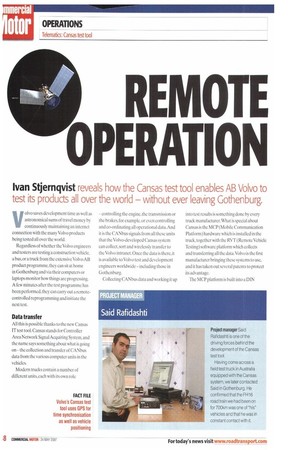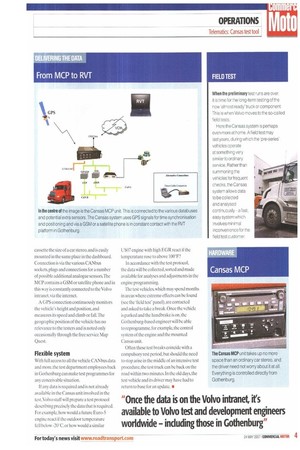REMOTE OPERATION
Page 48

Page 49

If you've noticed an error in this article please click here to report it so we can fix it.
Ivan Stjernqvist reveals how the Cansas test tool enables AB Volvo to test its products all over the world — without ever leaving Gothenburg.
Volvo saves development time as well as astronomical sums of travel money by continuously maintaining an intemet connection with the many Volvo products being tested all over the world.
Regardless of whether the Volvo engineers and testers are testing a construction vehicle, a bus, or a truck from the extensive Volvo AB product programme, they can sit at home in Gothenburg and via their computers or laptops monitor how things are progressing. A few minutes after the test programme has been performed, they can carry out a remotecontrolled reprogramming and initiate the next test.
Data transfer
All this is possible thanks to the new Cansas IT test tool. Cansas stands for Controller Area Network Signal Acquiring System, and the name says something about what is going on the collection and transfer of CANbus data from the various computer units in the vehicles.
Modern trucks contain a number of different units, each with its own role controlling the engine, the transmission or the brakes, for example, or even controlling and co-ordinating all operational data. And it is the CANbus signals from all these units that the Volvo-developed Cansas system can collect, sort and wirelessly transfer to the Volvo intranet. Once the data is there, it is available to Volvo test and development engineers worldwide including those in Gothenburg.
Collecting CANbus data and working it up into test results is something done by every truck manufacturer.What is special about Cansas is the MCP (Mobile Communication Platform) hardware which is installed in the truck, together with the RVT (Remote Vehicle Testing) software platform which collects and transferring all the data. Volvo is the first manufacturer bringing these systems to use, and it has taken out several patents to protect its advantage.
The MCP platform is built into a DIN
cassette the size of a car stereo, and is easily mounted in the same place in the dashboard. Connection is via the various CANbus sockets, plugs and connections fora number of possible additional analogue sensors.The MCP contains a GSM or satellite phone and in this way is constantly connected to the Volvo intranet, via the interact.
A GPS connection continuously monitors the vehicle's height and position, and measures its speed and climb or fall.The geographic position of the vehicle has no relevance to the testers and is noted only occasionally through the free service Map Quest.
Flexible system
With full access to all the vehicle CANbus data and more, the test department employees back in Gothenburg can make test programmes for any conceivable situation.
If any data is required and is not already available in the Cansas unit involved in the test,Volvo staff will prepare a test protocol describing precisely the data that is required. For example, how would a future Euro-5 engine react if the outdoor temperature
fell below -20°C. or how would a similar US07 engine with high EGR react if the temperature rose to above 100°F?
In accordance with the test protocol, the data will be collected, sorted and made available for analyses and adjustments in the engine programming.
The test vehicles, which may spend months in areas where extreme effects can he found (see the 'field test' panel), are contacted and asked to take a break. Once the vehicle is parked and the handbrake is on, the Gothenburg-based engineer will be able to reprogramme, for example, the control system of the engine and the mounted Cansas unit.
Often these test breaks coincide with a compulsory rest period, but should the need to stop arise in the middle of an intensive test procedure, the test truck can be back on the road within two minutes. In the old days, the test vehicle and its driver may have had to return to base for an update.






















































































































































































